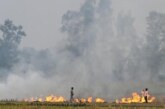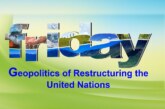
 #Waterscarcity involves #waterstress, #watershortage or deficits, and #watercrisis. This may be due to both natural and human factors. But, many reports suggest that the scarcity is more due to the human factor than anything – such as #industrialization, #irrigation, domestic use, etc. #Waterscarcity is the lack of sufficient available #waterresources to meet the demands of water usage within a region. It already affects every continent and around 2.8 billion people around the world at least one month out of every year. More than 1.2 billion people lack access to #cleandrinkingwater.Currently, #agriculture is the largest consumer of water, accounting for 84 per cent of total available water, followed by industry accounting for 12 per cent and domestic sector accounts for 4 per cent. Some experts have argued that India, which currently uses 2 to 4 times water to produce one unit of major food crops as compared to other major #agriculturalcountries like #China, #Brazil and the #UnitedStates, can save half of water presently used for #irrigation purposes if it attains #wateruseefficiency of those countries.
#Waterscarcity involves #waterstress, #watershortage or deficits, and #watercrisis. This may be due to both natural and human factors. But, many reports suggest that the scarcity is more due to the human factor than anything – such as #industrialization, #irrigation, domestic use, etc. #Waterscarcity is the lack of sufficient available #waterresources to meet the demands of water usage within a region. It already affects every continent and around 2.8 billion people around the world at least one month out of every year. More than 1.2 billion people lack access to #cleandrinkingwater.Currently, #agriculture is the largest consumer of water, accounting for 84 per cent of total available water, followed by industry accounting for 12 per cent and domestic sector accounts for 4 per cent. Some experts have argued that India, which currently uses 2 to 4 times water to produce one unit of major food crops as compared to other major #agriculturalcountries like #China, #Brazil and the #UnitedStates, can save half of water presently used for #irrigation purposes if it attains #wateruseefficiency of those countries.
#India accounts for about 17 per cent of the world’s population but only 4 per cent of the #worldfreshwaterresources, more than 80% of water needs of the country is met by exploiting the #groundwaterresources of India. This has aggravated the depletion of water table, and led to an unprecedented water shortage. Of the total cultivable area, about 60% is rain-fed and remaining 40% is dependent on irrigation. Undoubtedly, irrigation potential created from various irrigation schemes has recorded massive increase representing about 81% of India’s ultimate #irrigation potential entailing a limited scope for further expansion of #irrigationinfrastructure on a large scale; nevertheless, irrigation is predicted to remain the dominant user of water in the years to come.
Numerous regions in the country are chronically faced with acute water stress. These include districts of #SouthandNorthInteriorKarnataka; #RayalseemainAndhraPradesh; #VidarbhaandMarathwadainMaharashtra; #westernRajasthanandBundelkhandregionofUttarPradeshandMadhyaPradesh Low and erratic #rainfall for consecutive years in these districts have rendered water-harvesting structures devoid of water and the conservation measures almost unviable. The water storage in reservoirs has depleted leading to scarcity of drinking water. The moisture index in majority of these districts in the range of -85 to -50%, denoting that natural precipitation is highly inadequate to support the arable cropping. Neither normal agricultural practices nor the contingency measures may help the farmers. Experts have called for focusing specific attention on linking these districts with some perennial #sourceofwater.
The #rainfedgroundwaterreservoirs are over exploited due to high demand and shortage of supply through #rainfall. A significant fraction of the #rainfall flows into the ocean without being arrested by any #aquifers or #waterbodies. The potential retrieval of this water to compensate for the scarcity of groundwater in the region can be addressed through #rainwaterharvesting program either through lakes or shallow #aquifer or revival of #traditionalwaterconservationbodies.
#RainwaterManagementinMeghalaya
#Meghalaya, being the main beneficiary of the southwest Monsoons, receives very high rainfall, higher than most parts of the country. The rainfall varies in the state, from more than 12000mm in the southern slopes and close to 2000mm in the northern slopes. However, the rainfall is only for 6-8 months in a year, leaving the dry months with lots of water scarcity problems since there is 90% runoff. And due to the distinct topographical and geo-morphological conditions of the state, there is high surface run off to the neighboring plains very quickly. In total, #rainwaterdischarge from 11,667 sq km of catchment area in the state drains into the #Brahmaputrabasin and the rest 10,650 sq km into the #BarakBasin. It is anticipated that the State requires about 15 BCM of stored water annually for meeting the #waterrequirementsfordrinkingwater, #irrigation and other #livelihood generating activities such as #fisheries etc.
With all the factors, including the uncertainty of rainfall, the water availability situation in #Meghalaya is grim. Increasing water availability throughout the year in the State by providing storage facilities through #rainwaterharvesting have been given importance and various projects have already been taken up by the State government under its #IntegratedBasinDevelopmentandLivelihoodProgramme (#IBDLP), which has been implemented in a mission mode via over 20 missions by the Meghalaya Basin Development Authority (#MBDA), Government of Meghalaya. As a start, the Government has initiated programmes like #Jalkunds, #MultipurposeReservoirs (MRs) and #RoofTopWaterRainWaterharvesting as tools to #implementRainwaterHarvesting in the state.
#IndiaWaterFoundation (#IWF) is a development partner of the #MeghalayaBasinDevelopmentAuthority (#MBDA), #GovernmentofMeghalaya, in managing #waterresources in the state. Inputs from IWF have helped in the adoption of Integrated Basin Development and Livelihood Programme by the MBDA, which also looks after #water and #agriculture sectors in tandem with respective government departments.
In the aftermath of the implementation of the #IBDLP in a mission-mode, the trend in water conservation and rainwater harvesting is gradually undergoing change for the better because mechanism is in place in the form of Jalkunds (#smallwaterreservoirs), #MultipurposeReservoirs (MRs) and #RooftopRainwaterHarvesting to provide water during the lean period and these measures are reportedly yielding fruitful results in terms of easing the water situation during the lean season.
#JalkundsProgramme
 Jalkunds are small water harvesting structures that supplement the crop water requirement during the dry season where numerous types of crops may be grown and also helps expand the #irrigationcoverage especially in areas which are on the fringes of existing command areas which have already been covered by irrigation facilities. The #Jalkunds programme is restricted to a total command area of 10ha. It has become a boon especially to many small &marginal farmers in the interior most parts of the state, who would otherwise not be eligible for most of the irrigation schemes.
Jalkunds are small water harvesting structures that supplement the crop water requirement during the dry season where numerous types of crops may be grown and also helps expand the #irrigationcoverage especially in areas which are on the fringes of existing command areas which have already been covered by irrigation facilities. The #Jalkunds programme is restricted to a total command area of 10ha. It has become a boon especially to many small &marginal farmers in the interior most parts of the state, who would otherwise not be eligible for most of the irrigation schemes.
According to broad estimates, over 600 Jalkunds have been created to help create irrigation potential of 1942.46 hectare benefitting 1983 development partners and these schemes are being implemented through the #DistrictWaterResourcesCouncils (#DWRCs).
Viewed in a broad perspective, #Jalkunds are small micro- rain water harvesting structures to preserve the water resource that is available abundantly during the monsoon and for utilization them during the lean periods. Initially, attention was focused on type-I jalkund structures because this type of rain water harvesting was deemed suitable in location where there are negative spaces and the topography allows for the surface runoff/ natural drainage to be blocked by an impounding structure. The water impounded from these structures can then be conveyed by gravity to the required locations through canals or pipe.
Subsequently, only 5-10 type-II structures of #Jalkunds were implemented on a model basis. These structures are suitable mostly on hill tops, where the collection of rainwater is in-situ. These structures can vastly help in converting jhum cultivation areas. The target area for these structures is more localized as the storage of water is completely dependent on the rain water that falls directly from the sky. The coverage will also depend on the size of the pond and the crops planted.
The avowed objective of these Jalkunds is to achieve the goal of providing access to #irrigationwater to every farmer in the state by the end of the 12th five year plan period. In view of various Agro-climatic zones in the state, different types of #Jalkunds are being implemented based on the need assessment of the farmer in consultation with the District Water Resources Council. These jalkunds are being placed strategically, based on the topography of the area and is not detrimental on the activities of the village in any way.
#MultipurposeReservoirs (MRs)
Multipurpose Reservoirs (MRs) are water resources structures that will cater to the different water needs of the community by providing water solutions for various needs such as Drinking & #DomesticWater, #Irrigation, #Fisheries, #Livestock, #Microhydel, etc, wherever feasible. In addition, components like capacity building, institution building, #ManagementInformationSystem (#MIS), monitoring & evaluation, entrepreneurial promotion, etc have also been included to ensure that programme is successful.
The MRs have Structural components, Non-structural components and ancillary components. Structural components entail a combination of components for different uses such as #Drinking & #DomesticWater, Irrigation, #Fisheries, #Livestock, #Microhydel (< 100kw; where ever feasible) etc. Non-structural components comprise #capacitybuilding, #institutionbuilding, #ManagementInformationSystem (#MIS), monitoring & evaluation, entrepreneurial promotion, etc.; and ancillary components include #waterfiltration, #soilfertilitytesting, #watertestingkits, improvement of traditional sources, improvement of catchment areas, conveyance systems through canals and pipes, etc.
#RoofTopRainWaterHarvesting
Realizing the importance of having adequate and #cleanwatersupplyinHealth Centers across the state, the government of Meghalaya is proposing to construct #rainwaterharvestingstructures in #PrimaryHealthCenters and #CommunityHealthCenters located all over the state. The water will be stored in 50,000-1,00,000 liters tanks which will supplement the daily #domesticwater requirements. It is anticipated that this programme will cover #schools and #colleges, #institutions, #offices, etc in due course of time.
India is already a water-stressed country and moving towards turning #waterscarce. #Waterscarcity has many negative impacts on the environment, including #lakes, #rivers, #wetlands, and other fresh #waterresources. The resulting water overuse that is related to #waterscarcity, often located in areas of #irrigationagriculture, harms the #environment in several ways including increased #salinity, #nutrientpollution, and the loss of floodplains and wet. This Meghalaya Approach can prove to be a milestone in resolving the country’s water crisis.
#DrArvind KumarPresidentIndiaWaterFoundation, New Delhi.
http://oneindiaonepeople.com/wp-content/uploads/2016/06/July-16.pdf



